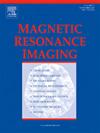脑小血管疾病的神经血管耦合改变:多延迟ASL和功能磁共振成像对认知障碍的看法。
IF 2
4区 医学
Q2 RADIOLOGY, NUCLEAR MEDICINE & MEDICAL IMAGING
引用次数: 0
摘要
背景:探讨脑血管病(CSVD)中神经血管耦合(NVC)的改变、神经影像学指标与临床评价的关系以及分类指标。方法:根据CSVD量表和蒙特利尔认知评估量表将参与者分为健康对照组、认知正常的CSVD和认知障碍的CSVD。结合经动脉转运时间调整后的脑血流量(CBF)和动态/静态低频波动幅度(dALFF、ALFF)评估NVC并确定组间差异。对异常脑区测量值与临床评估评分进行部分Spearman相关性分析。采用多变量模式分析确定组间最有效的分类指标。结果:与健康对照组相比,CSVD患者的交叉体素相关性较低。异常脑区主要出现在感觉运动皮层、边缘/副边缘系统和基底节区。值得注意的是,在这些领域的临床评估得分和nvc相关指标之间的相关性在校正前是显著的。CBF/ALFF比值在健康对照组和认知正常的CSVD患者中表现出优越的分类性能,而dALFF和CBF结合可有效区分认知正常和认知受损的CSVD患者。结论:我们的研究发现,使用at校正的CBF、dALFF和ALFF进行神经血管解耦,并为伴有/不伴有认知障碍的CSVD提供了有效的分类指标,可能改善诊断和治疗策略。本文章由计算机程序翻译,如有差异,请以英文原文为准。
Neurovascular coupling alterations in cerebral small vessel disease: A multi-delayed ASL and fMRI perspective on cognitive impairment
Background
To explore the alteration of neurovascular coupling (NVC), relationships between neuroimaging metrics with clinical assessments, and classification metrics in cerebral small vessel disease (CSVD).
Methods
Participants were grouped into healthy control, CSVD with normal cognition, and CSVD with cognition impairment according to CSVD scales and Montreal Cognitive Assessment. Cerebral blood flow (CBF) adjusted for arterial transit time and dynamic/static amplitude of low-frequency fluctuation (dALFF, ALFF) were combined to evaluate NVC and to determine intergroup differences. Partial Spearman Correlation between measures from abnormal brain areas and scores of clinical assessments were operated. Multivariate pattern analysis was applied to determine the most effective classification metrics among groups.
Results
Cross-voxel correlation was lower in CSVD compared to healthy control. Abnormal brain regions were presented mainly in sensorimotor cortex, limbic/paralimbic system, and basal ganglia in CSVD. Notably, correlations between clinical assessment scores and NVC-related metrics in these areas were significant before correction. CBF/ALFF ratio exhibited superior classification performance between healthy control and CSVD with normal cognition, while a combination of dALFF and CBF effectively differentiated between CSVD patients with normal and impaired cognition.
Conclusions
Our investigation finds neurovascular decoupling using ATT-corrected CBF, dALFF and ALFF, as well as suggests effective classification metrics in CSVD with/without cognition impairment, potentially improving diagnostic and therapeutic strategies.
求助全文
通过发布文献求助,成功后即可免费获取论文全文。
去求助
来源期刊

Magnetic resonance imaging
医学-核医学
CiteScore
4.70
自引率
4.00%
发文量
194
审稿时长
83 days
期刊介绍:
Magnetic Resonance Imaging (MRI) is the first international multidisciplinary journal encompassing physical, life, and clinical science investigations as they relate to the development and use of magnetic resonance imaging. MRI is dedicated to both basic research, technological innovation and applications, providing a single forum for communication among radiologists, physicists, chemists, biochemists, biologists, engineers, internists, pathologists, physiologists, computer scientists, and mathematicians.
 求助内容:
求助内容: 应助结果提醒方式:
应助结果提醒方式:


